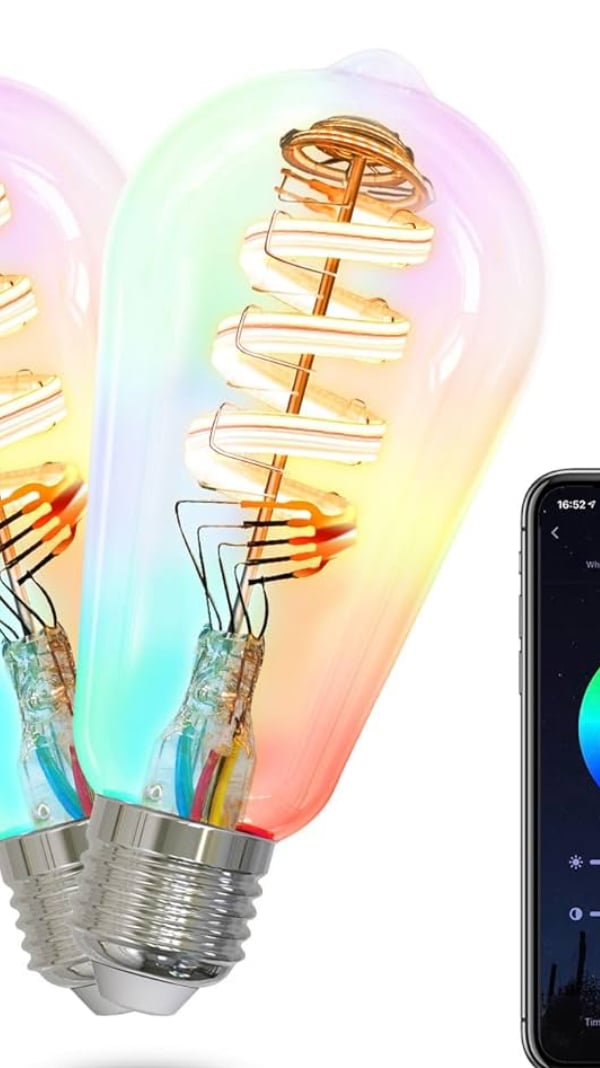How come LED Light Bulbs only last for about 2-3 Years?
I’ve bought and replaced a lot of light bulbs, and I noticed that all of them said “up to 20,000 hours” which would be about 5 years given 12 hours of daily use (which we definitely don’t).
I have a dozen that run 12+ hours a day. I’ve had 1 fail in 5 years.
Don’t buy cheap LEDs, and don’t put them in enclosures that trap heat.
Speaking from experience: LED drivers hate dirty power. If they burn out frequently, check the wiring for damage. I probably avoided a house fire.
Dirty power? Aww geez it’s been a few years since I last washed and waxed my power lines. Guess I gotta open up the walls again.
That’s a good point. LEDs dislike unstable power a LOT more than incandescent or fluorescent.
As an EE graduate I want to hear more about what dirt means and what driver can be affected by it. I’d expect power electronics to stand 100% over voltage over short periods and easy 20% long term, which would blow up lots of other things on the house before the driver or the LED starts performing worse.
The same reason that western countries refused to buy the extremely hard to break Superfest glasses manufactured in the GDR (East Germany) during the Cold War: planned obsolescence and consumable goods mentality in the interest of profit (they got a west German salesman to take the glasses to a trade show, and nobody gave a shit, because part of the industry’s profit model at the time was the sale of new glass due to breakage.
In point of fact: better, longer lasting LED bulbs DO exist, but they’re only sold in Dubai (due to the monarchy there basically decreeing that they wanted that to happen, so Phillips made them for them, but will NOT sell them outside of the country, because it would kill their sales elsewhere).
They’ve been sabotaged by design. LEDs should last 10+ years if built even half away reasonably, but unfortunately the manufacturers basically got together and agreed to build them in such a way they would fail. Same as regular light bulbs, they just have to work harder.
I still have some of the earliest modern LED bulbs on the market–old Philips ones, the AmbientLED (i think) with the yellow casing and large heat sinks. They’ve been running for like 15 years now and not a one of them has failed. I spent several hundred USD replacing all my bulbs with those back in the day and they’ve done me well.
Modern bulbs are trash by comparison. Not because the technology is limited in some way but because they refuse to make anything to that quality anymore.
We need an alternate solution to this planned obsolescence bullshit. Light bulbs hit 50k rated hours long ago and they were talking about making ones that went 100k+ but these days you can’t find anything above 25k. And that’s setting aside the fact that a lot of these rely on apps that could be dropped at a moment’s notice.
I still have some of the earliest modern LED bulbs on the market–old Philips ones, the AmbientLED (i think) with the yellow casing and large heat sinks.
I bought a couple of those for an enclosed fixture inside a skylight. The ceiling height there is 20 feet, plus another 2ft into the skylight tunnel. I bought those LED bulbs (at $40/each) because I never wanted to change them. Both bulbs were still fully functional 15 years later. I have since sold that house, but I bet they’re still functioning.
I replaced my mom’s can lights with LEDs and I was an early adopter. I believe it was ~2012-15 ish. Not a single one has died. The only reason any of them fail now is poor quality and / or planned obsolescence. The tech itself is solid AF. I had some bulbs I got from IKEA for $1. Those have failed countless times.
Get the ones with the strip LEDs that look like they’re trying to emulate a glowing tungsten filament. I can’t remember where I got the information; it was like the Technology Connections YouTube channel or something, but I remember them saying that since they put the LED lights in series on those bulbs, they have a much higher voltage requirement to drive them, and much less circuitry is needed. It’s the circuitry that burns out, and many of these filament-style LED lights literally only have a resistor as their main component.
I’ve swapped to these kinds of LEDs like…5 years ago, and haven’t had one burn out yet. Probably have like…15 of them across the entire house.
https://youtu.be/fsIFxyOLJXM?si=4wz0wa355Wd9gkUP&t=1389 – YEP – Found the advice. Starts at 23:09 BigCliveDotCom also says the same in his episode about Dubai Lamps: https://www.youtube.com/watch?v=klaJqofCsu4
Almost every bulb in my house is the filament style and it’s always surprising when one dies. The 4 in my porch lights are on 24/7, in all weather of course, and have been for 4 years.
i have 7 bulbs since 2019
none of them failed so far.all the lifespans i found ranged between 15.000 to 25.000 hours ( which btw was equated to 1.000 hours per year instead of 5.000 per year)
so this doesn’t sound normal to me.
how manny(in use) bulbs do you have?
what brands do you use?Mine work for I think over 10 years now. Some of the actual LEDs inside died but you don’t really notice 1-2 of 200 inside the bulb being dark.
Smart bulbs like this:

Have PCBs with small LEDs surface mounted to them. This means that the on-off cycle of the bulb causes heat deformation cycles of the PCB. This stresses the foils in the PCB and can eventually cause them to lose connection. That’s one of the reasons why they’ll often start flickering or lose the ability to be cool white, warm white, or specific colors (the different kinds of LEDs in them).
But bulbs like this (often called smart edison bulbs):

Use longer/larger LEDs that aren’t mounted to the PCBs, and will probably last much longer. They are better at not overheating their own electronics.
If you want the first kind to last longer, don’t run them above ~60% brightness.
Typically it’s not the emitters – the LED’s themselves – that fail. If driven correctly, those have lifetimes of tens of thousands of hours. That’s what the manufacturer is advertising on the box. Yes, an individual LED when driven correctly will probably last 20,000 hours. (Usually more, depending on how pedantic you want to get. The 20,000 hour figure often quoted is the point where the emitter drops to 80% of its original light output.)
LED “bulbs,” the type that replace filament bulbs in consumer fixtures, typically fail in their driver hardware. LED’s run off of low voltage DC and in the base of all of those LED conversion bulbs is a power conversion assembly that steps down and rectifies 120v/240c AC to whatever DC voltage the LED array in there expects. These are inevitably made out of whatever the cheapest passives and semiconductor components the manufacturer thinks they can get away with. These don’t last 20,000 hours, especially not in where they’re usually installed.
The main killer for all semiconductor electronics, which includes both LED’s themselves and their driver circuitry, is heat. This is often exacerbated by the fact that LED replacement modules are usually stuck in enclosed light fixtures designed for filament bulbs that have insufficient ventilation to get rid of the waste heat from the components in an LED module. The insides of those enclosed ceiling light fixtures, the ubiquitous “boob light,” gets hot, even with only LED modules installed. Filament bulbs don’t care because they don’t have any electronics in them and how they work is literally by getting so hot the glow. But LED modules in that kind of environment will invariably suffer an early failure.
The best way you can get your LED modules to last longer is to install them in a fixture where they’ll have a lot of air circulation available or at the very least which is not fully enclosed.
Hah, I have one three bulb boob light that’s my “trash” fixture because it gets whatever mismatched leftover I can find. At one point I had an LED, and incandescent and a CFL in it. It doesn’t have the extra ventilation that modern ones do so I’m sure it gets hot, but even that doesn’t seem to shorten the lives much
The bulbs themselves are amazing. There are good ones in cars and computers, the flash of phones etc.
The failure point is typically the electronic components that run or regulate it. And of course most companies want to sell more bulbs so they conveniently skimp on that stuff. So maybe the answer is a more expensive bulb that hopefully will last long enough to justify the extra cost?
What would you recommend that actually last long enough to justify the extra cost?
If you can get a hold of Dubai Led bulbs, they are supposed to last extremely long
https://hackaday.com/2021/01/17/leds-from-dubai-the-royal-lights-you-cant-buy/
If you’re technically inclined, Big Clive has a tutorial for ‘fixing’ most bulbs not to overdrive the LEDs by removing or changing a single resistor. https://www.youtube.com/watch?v=5HTa2jVi_rc
Make sure to choose lamp fittings that don’t trap the heat.
I’ve had sets of LED under-cabinet lights powered on 24/7 for about 14 years. I think one bulb went bad, out of 12.
What would you recommend?
Philips.
I have had the same light bulbs since 2012. One of them broke when I dropped it while moving. Otherwise, no issues at all. Philips brand that I bought a box of 12 of when I moved into an apartment that year. Maybe I’m just lucky, but still no issues.
They don’t? What are you talking about?
Cheap ones do.
I have still to have a led light break. They just never do, I buy mine at aliexpress or IKEA or wherever.
I have never had that happen and I buy my bulbs from the grocery store
I’ve had brand new ones that were duds before.
US?
Is Lemmy worse than Reddit to answer no stupid questions?
They never last that long, as they easily get away with it.
In one of the gulf states, though (Dubai?), they actually have only longer lasting LED lights for sale, as the minister responsible for regulation is something like an EE and forced the LED bulb providers to make a special version of those bulbs that basically last for ever. Those are only sold in that country, and hard to come by elsewhere.




